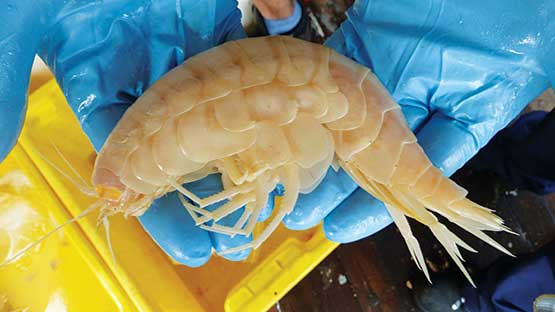Whitman student part of expedition that discovers a “supergiant” creature in one of the deepest places in the ocean

Photo credit: University of Aberdeen, UK.
There is nothing spectacular about amphipods. In fact, the tiny crustaceans, cousins to a typical potato bug, are particularly common in the deep sea.
But scientists have discovered a ‘supergiant’ amphipod more than four miles deep in the waters north of New Zealand, and Mackenzie Gerringer ’12 was part of the research team that found the 11-inch creature, which is nearly 10 times that of a normal amphipod.
The team also caught on film a specimen that measured 13 ½ inches long.
“It was very exciting when the traps came up, because sometimes they don’t come back up from those depths,” said Gerringer, who was onboard the research vessel Kaharoa processing the newly-discovered animals. “But sometimes they come up with stuff we’ve never seen before. Like the amphipod.”
The supergiant amphipod was discovered during a joint United Kingdom and New Zealand expedition to the Kermadec Trench north of New Zealand. The expedition was led by scientists from the University of Aberdeen and National Institute of Water and Atmospheric Research.
Paul Yancey, professor of biology and Carl E. Peterson Endowed Chair of Sciences at Whitman College, sent Gerringer on the expedition to conduct research in preparation of his upcoming journey to the Kermadec and Mariana Islands, volcanic arcs located north of New Zealand and east of the Philippine Sea. These are the two deepest spots on the globe.
Yancey’s forthcoming voyage is called Project Hades (for Hadal Ecosystem Study). His project attracted the National Science Foundation’s attention in the form of a $93,891 grant. National Geographic is also interested in a potential television special about Yancey’s history-making expedition.
Yancey plans to deploy the deep-sea diving Nereus sub to explore 36,000 feet below the surface of the ocean.
“We don't know what we will find, but we are bound to discover new species,” Yancey said.
— Edward Weinman
To find out more about Paul Yancey’s trip to the bottom of the ocean, pick up the March 2012 edition of Whitman Magazine, which will include a feature on the professor’s deep-sea adventure.
In the news
‘Supergiant’ crustaceans found near New Zealand — Discovery News
'Supergiant' crustacean found in deepest ocean — BBC
‘Supergiant’ amphipods discovered 7 km deep — University of Aberdeen
Scientists find 'supergiant' from the deep — Stuff.co.nz
'Supergiant' crustaceans found deep in waters off New Zealand — The Daily Mirror
Aberdeen scientist finds deep sea 'supergiant' - video from the Evening Express
Supergiant amphipod, monster crustacean, found in deep seas off New Zealand — The Global Post